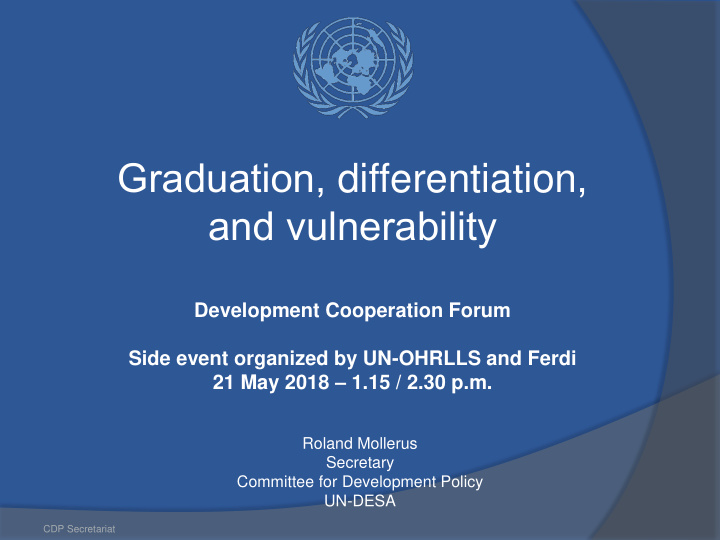



Graduation, differentiation , and vulnerability Development Cooperation Forum Side event organized by UN-OHRLLS and Ferdi 21 May 2018 – 1.15 / 2.30 p.m. Roland Mollerus Secretary Committee for Development Policy UN-DESA CDP Secretariat
Background United Nations Committee for Development Policy (CDP) Subsidiary body of ECOSOC • 24 independent experts Policy advice to ECOSOC
CDP work on LDCs Reviews triennially the list of LDCs • Recommends countries for inclusion and graduation • Core mandate of the CDP • Triennial reviews since 1991 • ECOSOC endorses the recommendations • General Assembly takes note Developed and refines the criteria and procedures for identifying LDCs • Endorsed by ECOSOC and General Assembly • Current criteria confirmed in 2017 • Multi-year work programme (2017-2020) Monitors graduating and graduated LDCs Analytical papers on LDCs
LDC criteria and indicators LDCs are low-income countries suffering from the most severe structural impediments to sustainable development. Economic Human assets GNI per capita vulnerability index (HAI) index (EVI) Population Percentage of population Remoteness undernourished Merchandise export Under-five mortality rate Maternal mortality rate concentration Share of agriculture , forestry and fisheries in Gross secondary school GDP enrolment ratio Share of population in low Adult literacy rate elevated coastal zones Victims of natural disasters Instability of agriculture production Instability of exports of goods and services
EVI Measures structural vulnerability to economic and environmental shocks • Name ‘EVI’ is slightly misleading • External trade shocks • Natural disasters • Permanent climate change shocks • Exclude purely policy-induced vulnerability • Refinements with equitable treatment over time
Key experiences Going beyond GNI/GDP has clear benefits Vulnerability is complex, but critical for development and highly policy relevant • Best used in conjunction with other criteria Transparency and simplicity are important Potential conflict: Stability vs improvement Data availability remains major concern • LDCs and small States most difficult
Graduation logic Binary logic: • Not adapted to the process of development • Apparent abrupt change in the country status • Development is continuous • Generates perverse incentives Addressing the binary nature
Supporting Graduation Supporting countries (through the UN system) in preparation of transition strategies Integrated in their national development strategies Assuring that all development partners mainstream the smooth transition needs in their approaches and strategies Monitoring the process of graduating countries to avoid setbacks
Orderly phasing-out Extension of markets access preferences to enable graduated countries to adjust to the new conditions Phasing out LDC-specific Special and Differential Treatment in the WTO Avoiding abrupt reductions in official development aid provided to graduated countries, both from bilateral donors and from multilateral institutions
Proposal: ODA and LDC criteria United Nations General Assembly call (A/RES/67/221): • Invites Development Partners to consider LDC indicators and criteria as part of their criteria for allocating ODA. Resolution based on suggestions by the CDP • Allows for better aligning ODA with needs • Avoids abrupt changes when countries graduate from LDC category CDP Secretariat
Formula-based ODA allocation used mainly by multilateral donors HAI and EVI can be integrated into formulas Most bilateral donors do not use formulas for allocating ODA HAI and EVI could be part of criteria to select priority countries Indicators within HAI and EVI could also be useful for allocations within priority themes CDP Secretariat
Recent work by CDP Ongoing concern of losing international support measures (ISMs) Going beyond smooth transition Incentives package for continued support in development & progress towards SDGs Different from smooth transition Country specific Demand driven Production transformation focus CDP Secretariat
Proposed category of countries facing extreme vulnerability to climate change and other environmental shocks Graduation of extremely vulnerable countries (such as Kiribati and Tuvalu) from the LDC category must not signal they no longer require special treatment International support needs to better address specific challenges of countries extremely vulnerable to environmental shocks Proposed new category should entitle countries to receive support specifically targeting these vulnerabilities CDP stands ready to assist in creating category • Development of suitable criteria for identifying countries • Analysis and design of support measures • CDP can build on its comprehensive review of the LDC criteria and take work on improved assistance to graduating countries into account
Thank you! Additional information: CDP.UN.org www.un.org/ldcportal CDP Secretariat
Recommend
More recommend